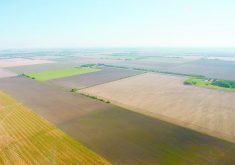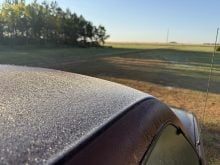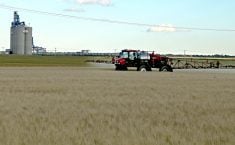Canadian commodity groups interested in exploiting the seemingly boundless potential of the aquaculture industry may want to follow the U.S. soybean example.
For the past five years, the United Soybean Board has spent millions of check-off dollars on developing ingredients suitable for farmed fish.
Money has poured into projects as diverse as designing cages for farm fish and developing a soybean inclusion rate database for farmed fish species.
Growers are starting to reap the benefits of that investment.
“It’s our fastest growing market. There is no question,” said Philip Bradshaw, director of the United Soybean Board, which oversees the investment of the U.S. soybean checkoff.
Read Also

Saskatchewan amends farm land ownership regulations
The Canada Pension Plan Investment Board can no longer own Saskatchewan farmland.
Bradshaw is more familiar with feeding soybeans to pigs on his farm in Griggsville, Illinois, than he is shipping his crop halfway around the world to a shrimp farm in China.
However, he and other directors believe that in the long-term, fish can rival hogs in soybean consumption.
Aquaculture already takes 5.5 million tonnes of U.S. soybeans annually, which is 202 million bushels of the crop.
“That is expected to double in 10 years to 440 million bu. of beans,” Bradshaw said, which equals 17 percent of current U.S. production.
“That’s big.”
Oilseeds are a good fit for farmed fish diets because of their high level of crude protein and strong amino acid profiles. Soybean meal is the primary protein source in the diets of many omnivorous species, such as catfish and tilapia.
However, inclusion rates were severely limited in the diets of carnivorous fish such as Atlantic salmon and rainbow trout, which appear to have almost an allergic reaction to the meal. Antinutritional factors in soybean meal cause inflammation of the gut, and indigestible non-soluble carbohydrates lead to fecal contamination of the water.
Soybean check-off money is being spent on efforts to increase inclusion rates but many believe more opportunity lies in processing to create concentrates.
Soy protein concentrate is an excellent substitute for fishmeal, which is the gold standard of ingredients in the diets of carnivorous fish, said Ron Hardy, director of the Aquaculture Research Institute at the University of Idaho, in a paper he wrote for an animal nutrition conference in 2005.
Until recently, the concentrate was twice the price of fishmeal, keeping it out of rations. However, a run-up in fishmeal prices has narrowed the gap. If prices continue to rise, as many expect, high-end products such as soy protein concentrate and corn gluten meal will become affordable alternatives.
Corn gluten meal is already widely used in salmon diets because of its high protein, albeit at low inclusion rates because of the cost factor.
Other candidates to replace fishmeal in carnivorous species include wheat gluten and protein concentrates made from canola, peas and lupins, said Hardy.
Murray Drew, an aquaculture specialist at the University of Saskatchewan, said canola concentrate is cheaper and can be used at higher inclusion rates than soy protein concentrate.
However, concentrates have their limits as well. The maximum amount of fishmeal that can be removed without having deleterious consequences is 60 percent, Drew said.
“You’re trying to trick a carnivore into becoming a vegetarian and that’s part of the problem,” he said.
“We’re not sure whether it’s something positive in the fishmeal or something negative in the plants. We’re trying to determine that and hopefully we’ll be able to get around using any fishmeal at all.”
Fully replacing fishmeal probably means finding the right combination of plant-derived ingredients in conjunction with supplements such as amino acids, flavourings and phytase, Hardy said. One crop won’t cut it.
That’s good news for western Canadian farmers who grow a multitude of crops, Drew said.
“That’s going to be a huge advantage for us because we have these oddball crops with different properties.”
He also sees opportunities for new pulses and oilseeds such as fababeans and camelina.
There is also opportunity for flax oil to replace fish oil, another key ingredient in aquaculture diets. Flax has the omega 3 properties needed for an oil replacement.

















